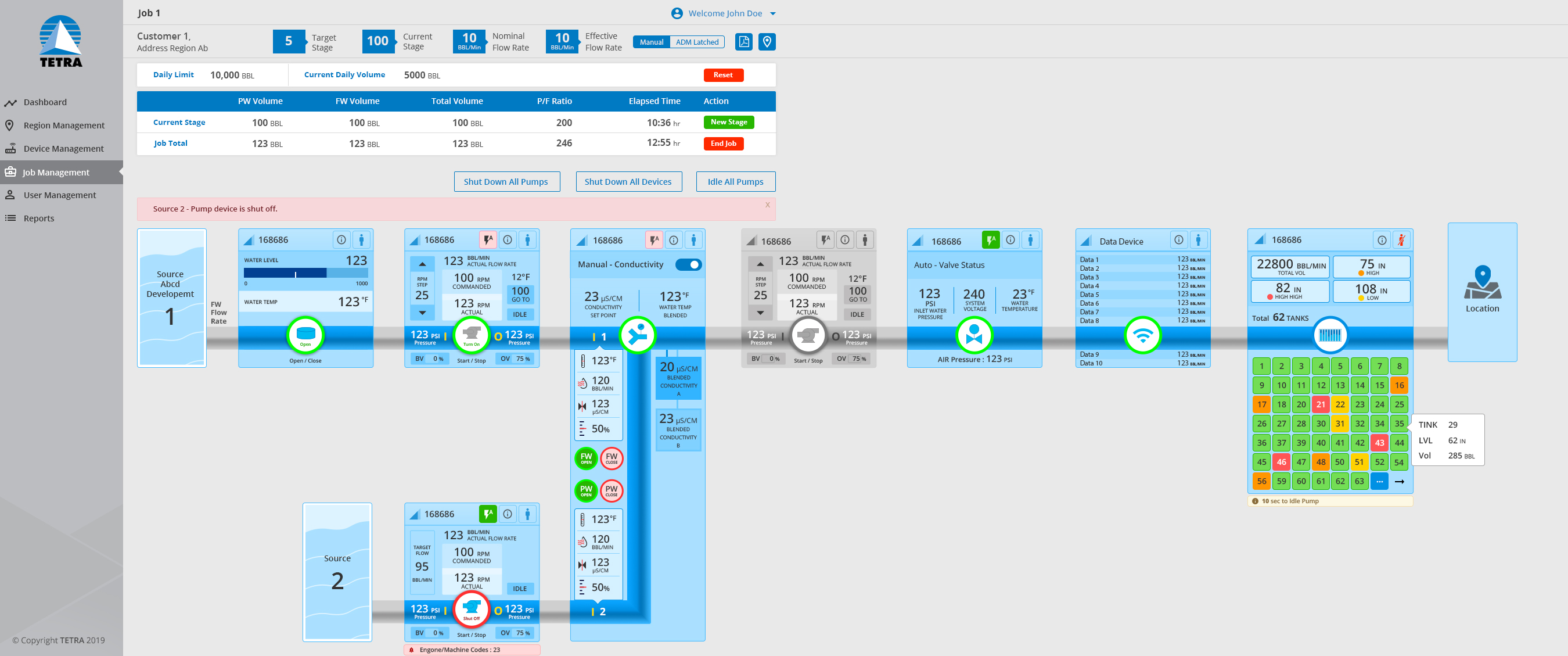Nowadays, the overriding concern in the oil and gas industry is maximizing efficiency — fine-tuning processes and operations to yield the greatest possible efficiency so as to reduce overall costs, minimize exposure to risk, and eliminate nonproductive time. One of the primary ways to achieve greater efficiency is through automation, which continues to transform a range of activities, from more precise drilling and flow control in the field to cloud data systems and remote monitoring of pipelines in the office.
The newest frontier of automation is water management, and leading the way is TETRA Technologies with its TETRA BlueLinx™ automated control system. The pioneering solution closes the loop on water management by providing automated remote monitoring and control of produced water transfer, storage, treatment and recycling, blending and distribution, as well as sand management.
What to do with all that water
Hydraulic fracturing at today’s multi-pad sites requires millions of barrels of water. When production comes online, the wells will produce millions more barrels of water from the geological formation — roughly four or five barrels of water for every one barrel of oil, and sometimes even more.
In the past, the produced water — which in its native state is unsuitable for fracturing — was usually transported to injection wells for disposal, whereas today that water can be recycled for operational use. With the right treatment and recycling system, produced water can be filtered, treated, and blended with fresh water in carefully controlled ratios to yield an optimal base fluid for fracturing.
A comprehensive water management solution, like the TETRA Lowest Cost per Barrel Water Management solution, will typically include several components: pumps and hoses for water transfer, tanks or pits for water storage, systems to remove sand as well as filter and treat the produced water, equipment to blend the recycled water with fresh water, and, finally, a mechanism to efficiently distribute the blended fluid.
Operating such a multi-faceted system requires careful coordination. With flowrates of 50,000+ barrels per day, regulating flow, tank level, filtration, and chemical treatment of the water entails myriad calculations and adjustments in real time.
Conquer the complexity with automation
A manual operation requires several workers on-site, especially if it consists of discrete components from different suppliers. The personnel will periodically check measurements like tank level and flow pressure and, when necessary, make adjustments and empty sand traps, but they’ll spend the bulk of their time doing little else — which is, of course, a very inefficient use of resources. Manual control also increases the risk of human error as well as the potential for safety and environmental incidents.
By contrast, an automated water management control system, like the TETRA BlueLinxsystem, requires only two or three people on-site, while the numerous calculations and adjustments are performed by a comprehensive computer-controlled program. Sensors on the pumps, valves, tanks, and other equipment send data to on-site programmable logic controllers, which then analyze the data and make adjustments based on predetermined metrics, bringing a greater level of precision and efficiency to operations.

The nerve center of the TETRA BlueLinx automated control system is the cloud-based dashboard connected via either cellular or satellite link to field equipment sensors. The dashboard displays the operating metrics of each asset in real time, providing immediate access to readings including inlet and outlet pressures, fluid composition, water conductivity, storage level, and equipment status and performance.
The benefits of the TETRA BlueLinx system
When applied to a comprehensive water management solution, the TETRA BlueLinx automated control system coordinates the various components to balance operations. For example, in a typical piecemeal setup, a substantial reduction of incoming produced water might not be accompanied by a corresponding change in chemical injection — this scenario would, at the very least, cost the operator money with no benefit, or worse, yield a fluid that is damaging to the formation. The TETRA BlueLinx automated control system aims to prevent such an error by dialing back the chemical content to match the water level.
Another benefit of the TETRA BlueLinx system is that it balances pressures and pump speeds, which can reduce consumption of the diesel fuel powering the pumps. With a manual setup, a technician might attempt to boost throughput by increasing a pump’s speed, not knowing that doing so actually yields no cost-effective advantage. With its multiple sensors, the TETRA BlueLinx automated control system would know this and accordingly regulate pump speeds for optimal performance, in some cases reducing fuel consumption as much as 30 percent — and burning less fuel means fewer truck trips to the site to refuel the pumps.
Off-site, personnel can remotely monitor and control operations via secure cellular or satellite connectivity using a PC or mobile device. Should connectivity be interrupted or severed, the on-site controllers maintain operations, thereby preventing issues like tank overflow. Customers, too, can login remotely and view their operations through the secure connection, pulling up digital twins of their equipment to check on operating parameters 24/7.
The TETRA BlueLinx automated control system constitutes a game-changing advancement in water management, one that enables operators to bring a newfound degree of efficiency and precision to water management while reducing costs and nonproductive time.
Visit www.tetratec.com/water or email us at water@tetratec.com for more information.

